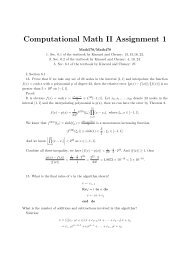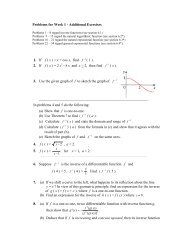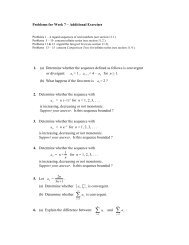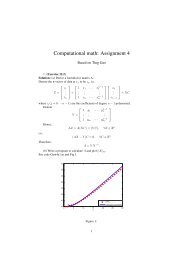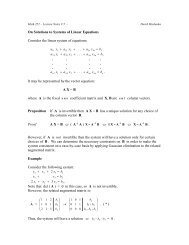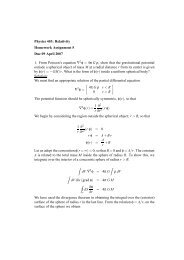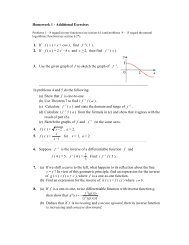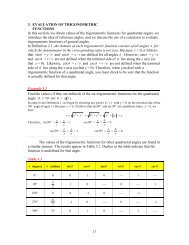Lecture Notes #2 on Graphing in 3-space with Maple (pdf)
Lecture Notes #2 on Graphing in 3-space with Maple (pdf)
Lecture Notes #2 on Graphing in 3-space with Maple (pdf)
Create successful ePaper yourself
Turn your PDF publications into a flip-book with our unique Google optimized e-Paper software.
Math 251-003 - <str<strong>on</strong>g>Lecture</str<strong>on</strong>g> <str<strong>on</strong>g>Notes</str<strong>on</strong>g> <str<strong>on</strong>g>#2</str<strong>on</strong>g> - Spr<strong>in</strong>g 2008 David Maslanka<br />
Directi<strong>on</strong> Cos<strong>in</strong>es<br />
The directi<strong>on</strong> angles α, β, and γ associated <strong>with</strong> a n<strong>on</strong>zero vector v determ<strong>in</strong>e three circles <strong>on</strong> the unit sphere as described<br />
below. Each of these <strong>in</strong>scribed circles is perpendicular to <strong>on</strong>e of the coord<strong>in</strong>ate axes and their comm<strong>on</strong> po<strong>in</strong>t of <strong>in</strong>tersecti<strong>on</strong><br />
determ<strong>in</strong>es the directi<strong>on</strong> of the vector uniquely.<br />
><br />
><br />
><br />
><br />
><br />
><br />
><br />
><br />
><br />
><br />
><br />
><br />
><br />
><br />
><br />
><br />
><br />
><br />
><br />
><br />
><br />
><br />
><br />
><br />
><br />
><br />
><br />
><br />
><br />
><br />
><br />
><br />
><br />
><br />
><br />
><br />
restart:<br />
<strong>with</strong>(plots):<strong>with</strong>(plottools):<br />
s:=sphereplot(1,theta=0..2*Pi,phi=0..Pi,style=wireframe,color=green):<br />
> Circle1:=<strong>space</strong>curve([1/2,sqrt(3)*cos(t)/2,sqrt(3)*s<strong>in</strong>(t)/2],t=0..6*Pi,color=navy):<br />
> for n from 0 to 63 do<br />
> y||n:=sqrt(3)*cos(n*Pi/32)/2;<br />
> z||n:=sqrt(3)*s<strong>in</strong>(n*Pi/32)/2;<br />
> c||n:=l<strong>in</strong>e([1/2,y||n,z||n],[0,0,0],color=navy);<br />
> end do:<br />
> C1:=seq(c||i,i=0..63):<br />
Circle2:=<strong>space</strong>curve([sqrt(13)*cos(t)/6,sqrt(23)/6,sqrt(13)*s<strong>in</strong>(t)/6],t=0..6*Pi,color=<br />
red):<br />
for n from 0 to 63 do<br />
x||n:=sqrt(13)*cos(n*Pi/32)/6;<br />
z||n:=sqrt(13)*s<strong>in</strong>(n*Pi/32)/6;<br />
c||n:=l<strong>in</strong>e([x||n,sqrt(23)/6,z||n],[0,0,0],color=red);<br />
end do:<br />
C2:=seq(c||i,i=0..63):<br />
Circle3:=<strong>space</strong>curve([sqrt(8)*cos(t)/3,sqrt(8)*s<strong>in</strong>(t)/3,1/3],t=0..6*Pi,color=magenta):<br />
for n from 0 to 63 do<br />
x||n:=sqrt(8)*cos(n*Pi/32)/3;<br />
y||n:=sqrt(8)*s<strong>in</strong>(n*Pi/32)/3;<br />
c||n:=l<strong>in</strong>e([x||n,y||n,1/3],[0,0,0],color=magenta);<br />
end do:<br />
C3:=seq(c||i,i=0..63):<br />
l1 := l<strong>in</strong>e([0,0,0], [1.8,0,0],color=black):<br />
l2 := l<strong>in</strong>e([0,0,0], [0,1.8,0],color=black):<br />
l3 := l<strong>in</strong>e([0,0,0], [0,0,1.5],color=black):<br />
t1:=textplot3d([1.7,0,-0.15,`x`],f<strong>on</strong>t=[TIMES,BOLDITALIC,36],color=black):<br />
t2:=textplot3d([0,1.6,-0.15,`y`],f<strong>on</strong>t=[TIMES,BOLDITALIC,36],color=black):<br />
t3:=textplot3d([0,0.15,1.4,`z`],f<strong>on</strong>t=[TIMES,BOLDITALIC,36],color=black):<br />
l4 := l<strong>in</strong>e([0,0,0], [1/2,sqrt(23)/6,1/3],color=black,thickness=3,l<strong>in</strong>estyle=2):<br />
l5 := l<strong>in</strong>e([1,1*sqrt(23)/3,2/3], [1/2,sqrt(23)/6,1/3],color=black,thickness=3):<br />
c:= sphere([1/2,sqrt(23)/6,1/3],0.015,color=black):<br />
t:=0.025:<br />
P:=[0.9+t*1/3,3*sqrt(23)/10+t*2/3,6/10-t*(sqrt(23)/3+1/2)]:<br />
t:=-0.025:<br />
Q:=[0.9+t*1/3,3*sqrt(23)/10+t*2/3,6/10-t*(sqrt(23)/3+1/2)]:<br />
R:=[1,1*sqrt(23)/3,2/3]:<br />
ar:=polyg<strong>on</strong>([P,Q,R],color=black):<br />
t4:=textplot3d([1,1*sqrt(23)/3,3/4,`v`],f<strong>on</strong>t=[TIMES,BOLDITALIC,38],color=black):<br />
arx:=polyg<strong>on</strong>([[1.8,0,0],[1.65,0.1,0],[1.65,-0.1,0]],color=black):<br />
ary:=polyg<strong>on</strong>([[0,1.8,0],[0.1,1.65,0],[-0.1,1.65,0]],color=black):<br />
arz:=polyg<strong>on</strong>([[0,0,1.5],[0.1,0,1.35],[-0.1,0,1.35]],color=black):
display(C1,Circle1,C2,Circle2,C3,Circle3,l1,l2,l3,l4,l5,t1,t2,t3,t4,c,s,ar,arx,ary,arz,<br />
orientati<strong>on</strong>=[44,74],scal<strong>in</strong>g=c<strong>on</strong>stra<strong>in</strong>ed);<br />
z<br />
v<br />
x<br />
y<br />
Note that every positi<strong>on</strong> vector which term<strong>in</strong>ates <strong>on</strong> the boundary of Circle1 makes an angle of<br />
= arccos( 1 2 ) = 60o <strong>with</strong> the positive x - axis.<br />
Each such vector term<strong>in</strong>at<strong>in</strong>g <strong>on</strong> the boudary of Circle2 makes an angle of<br />
23<br />
= arccos( ) = 36.9 o <strong>with</strong> the positive y - axis,<br />
6<br />
and every such vector term<strong>in</strong>at<strong>in</strong>g <strong>on</strong> the boundary of Circle3 makes an angle of<br />
= arccos( 1 3 ) = 70.5o <strong>with</strong> the positive z - axis.<br />
Observe that there is a unique po<strong>in</strong>t comm<strong>on</strong> to all three circles.<br />
Thus, the directi<strong>on</strong> angles: , , and determ<strong>in</strong>e a unique directi<strong>on</strong> for the positi<strong>on</strong> vector.



